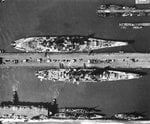parsifal
Colonel
That´s explainable by the increased accuracy and the different environment of firecontroll post war. I can assure You that the closest you could come with ww2 era firecontroll is hitting at direct fire only (no FC required, only point blanc range) or -most usual- straddling at anything else involving FC. With a mean salvo deviation of +-200 yards and more in range (68% of all falls are in within this distance to the MPI), there is simply no possibility to ask for a hit. You either straddle a target or You adjust the MPI acordingly to straddle. The hit on the other hand is a random event in within the probability limits of the straddle itselve. You may manipulate the probabilities a bit (that´s why half salvos are preferable to full salvos), but You can´t tighten the dispersion pattern beyond the limits of the gun / turret / projectile / propellant combination. The dispersion pattern for major calibre projectiles at realistic fighting range, however, is always much larger than any ship buildt in ww2.
Del
the differeneces are not that great, all of these variables you are talking about exist in the post war environment as they did during the war. that was not the point of my post. It was merely to point out that a straddle was not a hit, and should not be read as a hit. Moreover increasing the chances of a hit are connected to accurate FC. If the MPI is not estimated correctly, or it takes a long time to determine range speed and course, then the probability of a hit under those conditions will drop .
Re-read my original post, and you will find the measure of success was not that a straddle was obtained, but the number of hits over the number of rounds fired. That we are arguing about how to measure success in gunnery surprises me to be honest A straddle was a step in the right direction, but is still not a hit. We incidentally still needed to determine the target range course and speed to achieve a hit, and this often resulted in a straddle before registering a hit. I dont think I communicated this addequately in my previous posts. I was merely reacting to the inference that a straddle or a near miss was "as good as" a hit. Its not, either statistically or operationally.
The measure of accuracy in my opinion is how quickly a hit can be registered after fire is commenced. In Barents sea, Lutzow opened fire on Obdurate at just before noon, and the damage on the ship observed at 1204. though not a hit as such (splinter damage only) that suggests to me about 3 to four salvoes before any result was obtained. the range was 15400 metres, and visibility was reported at 14000 metres. I am unsure if there is an error in the range visibility reports, or if Lutzow was using radar to control her guns.
It would be interesting to compare that admittedly impressive effort with the RN cruisers efforts against the Eckoldt. I forget the details, but the time between the eckoldt being engaged and her sinking were very short.

